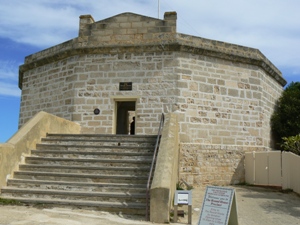
How my longing to trace descendants of my late mother's eldest brother, who emigrated to Western Australia with his wife and children in 1912, led me into a dream adventure.
PARTS 2 & 3: PERTH and FREMANTLE
Scenes I enjoyed in these two cities. To be expanded after my next visit!
PART 4: SEARCHING FOR MUNDIWINDI
..... let that page speak for itself.
PART 5: TO MARBLE BAR AND BEYOND
A journey up to Marble Bar (hottest place in Australia when it really gets going) and down the west coast of WA back to Perth.
A willy-willy, diamond mine, gold mine, overnight on a cattle station, School of the Air, aboriginal petroglyphs, stromatolites, it's all there - and more.
~~~~~~~~~~~~~~~
CONTACT PAGE
~~~~~~~~~~~~~~~
|
PART 3 OF DOWN UNDER ADVENTURE
FREMANTLE
During my time in Perth I took a trip down the Swan River to the sea, to Fremantle. There was a running commentary throughout the trip. Yes, well... bar one comment so memorable that I have no recollection of what it was about, there were masses of details of the millionaires' houses lining the banks most of the way, all the facts on who lived there now, who had lived there, how much the properties cost to build, what the current asking price was for those up for sale... "Oh...(plus a few other words)", I thought, what I had wanted to hear was the history of the area, of the Nyoongar aboriginal people whose home it once was, of the settlers and how they developed the land. What an opportunity lost. I concentrated on the river and tried not to hear, but "Now this one was built for so many million dollars..." droned the disembodied voice. At last the harbour was in sight with a view of the distant ocean, the boat drew alongside the quay and, overjoyed at escaping, I hurried off. At last I was at Fremantle, that spot on the coast of Western Australia that I had searched out in my atlas so many years ago - the place where Will had first arrived in Australia. The day was dull, overcast and threatening to rain on me as I stood on the quay looking out towards the Indian Ocean, as grey and cold as the North Sea that I had temporarily left behind. I looked around. This was where Will, his wife Fanny and children Jack and Doris had once stood with their possessions piled next to them. I would be returning home to England but, for Will and his family, Australia was now their country. Where did they sleep that first night? Did "the authorities", whoever they may have been, provide temporary quarters for those who had no friends or relatives to accommodate them? John has uncovered much of Will's life through his researches, but there are so many questions for which I shall probably never have an answer. Families in the 19th and early 20th centuries may not have moved around much from their local area during their day-to-day lives and yet so many of them took this great leap to countries on the other side of the world in the hope of making a fresh, a better, start. Some returned home, disillusioned, but many stayed and eventually made a go of it.
~~~~~~~~~~~~~~~ Drawn by Fremantle, on my return from the camping trip I later spent another couple of days there - making sure I caught the train on the succeeding visits. Whereas many of the older buildings in Perth were demolished years ago to be replaced by modern ones, including the towering skyscrapers in the business area down by the river, much of Fremantle's old colonial style architecture has been sympathetically restored. Despite the plethora of restaurants full of tourists spilling on to the pavements there was a pleasant, laid-back atmosphere over it all and, apart from the tourists and eateries, perhaps it was much as Will would have known it. The town takes its name from Captain Charles Fremantle who landed at Arthur's Head in 1829 from his ship HMS Challenger and claimed coastal WA for the Crown. Until the 1890's the entrance to the Swan River was blocked by a rock bar but then work began, first to blast a channel then to construct an Inner Harbour. When this was officially opened in 1897 Fremantle really took off as an important port. The town has a colourful market, a spanking new Maritime Museum and also an unusual Shipwrecks Museum housed in what was once a storehouse for the nearby jetty, built by convict labour in the mid-1800's. The latter houses many fascinating relics, one of which is a nearly 400- year-old pewter plate inscribed by Dirk Hartog, Commander of the Eendracht - a ship of the United Dutch East India Company - to record his landing in Australia in 1616. It was nailed to a post, to be succeeded by another in 1697 and is now on view in the museum. There are also many exhibits from wrecks dating back to the early 17th century, but the one I really wanted to see was the hull of the ship Batavia. This was a 17th century Dutch boat, larger than Cook's Endeavour, and was on its way to the East Indies with a cargo of money and jewels when it ran aground on islands off the Australian coast in 1629. There ensued a catalogue of mutiny, murder, setting adrift and general mayhem. Lovely, I thought, just the job. But, just my luck, the gallery was closed for refurbishment. I strolled through the town along the aptly nick-named Cappucino Strip, up to the old Fremantle prison built in 1858 by some of the convicts transported to WA in the 19th century. Nothing like building your own cell! It was in use until as late as 1991 and pretty grim it was, too. Even grimmer when I found that I'd arrived on a day when the cafe was shut. An earlier, much smaller, prison had been erected in 1830 on high ground by the river mouth, near where Captain Fremantle had landed. Known as the Round House (it is actually eight-sided) it is said to be the oldest public building still existing in WA. At first it was used as a local prison but later it housed aboriginal people before they were taken away to Rottnest Island. To them it is a sacred site because many of their people died while held there. Then, as the number of convicts transported from England increased, the Round House was outgrown, as you might say, and the larger one east of the town was built.
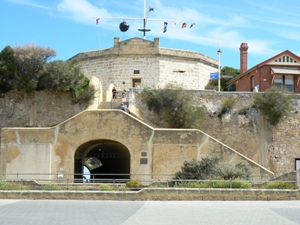 The Round House prison
Nearing it, I crossed the railway line, and then instead of using the steps decided to take the alternative approach through the tunnel, built in 1837 to give the whalers access to the town.
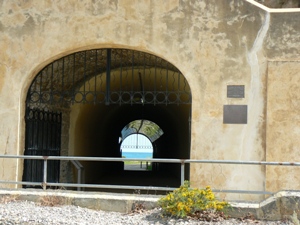 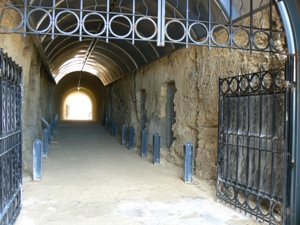
The Whalers' Tunnel
This brought me out on to the beach from which they used to cast off. On the high mound above stood the prison, while to one side I was intrigued to find a Time Ball like the world-famous one at Greenwich Observatory. It is apparently a replica of the original which was put in place in 1900 but which fell into disuse when it was superseded in 1937 by the advent of radio signals sent direct to ships. Climbing up, I had a look inside the prison first and found that it had eight cells and what used to be the gaoler's rooms all centred around a small courtyard. Not much room for exercise there! On display was some artwork done by one-time prisoners.
Close-up of the Round House
Back outside, there was a short while to go before the Time Ball was activated and, as a few other visitors began to gather, I leant on the low wall and became absorbed in the view down over the gently rolling breakers, along the distant quay of the harbour and out to the ocean.
 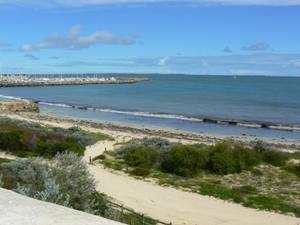 It was all so peaceful, just the distant chatter of the small crowd and the gentle splash of the sea below, a moment that, although passing in anticipation of the marking of the hour,
itself seemed timeless.
Then, my watch showing that it was coming up to 1 o'clock, I got my camera ready, focused, the Time Ball fell, the cannon fired.... and the moment had passed.
But my camera had captured it. The Time Ball Copyright Ivy Collins 2009 Go to Part 4: Searching for Mundiwindi
|

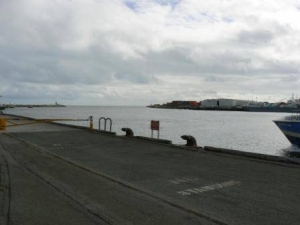 Did the sun shine for them that day in May 1912 as their small ship S.S. Australind, completing her seven week journey from Tilbury, England, steamed at last through that great wide Swan River mouth and tied up at its berth probably not far from where I stood? I tried to see into what must have been going through Will's mind as he caught his first sight of the port where they would at last step ashore on to Australian ground.
Did the sun shine for them that day in May 1912 as their small ship S.S. Australind, completing her seven week journey from Tilbury, England, steamed at last through that great wide Swan River mouth and tied up at its berth probably not far from where I stood? I tried to see into what must have been going through Will's mind as he caught his first sight of the port where they would at last step ashore on to Australian ground. 